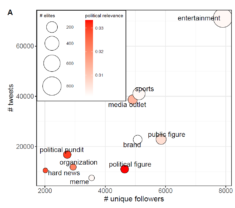The Non-Political Twitterverse
Much ink has been spilled decrying social media rabbit holes and political echo chambers that threaten our democracy by increasing hyper-partisanship and extremism.
What if that’s fake news? It’s true there are hyper-partisan people on Twitter. It’s also true many of these hyper-partisans are opinion influencers with big followings.
The problem with the echo-chamber thesis is the sampling is often done using political keywords to find political opinion leaders and followers. It’s the age old problem of sampling bias. And the political researchers and media folks doing all the analysis and reporting? They live in the biased sample.
As it turns out, the political echo chamber is there but it’s dwarfed by all the non-political activity on social. The typical American is far more apolitical than political or partisan. They also almost entirely tune out politics on social.
This table shows a list of opinion leaders ranked by the reach and influence (e.g., shares, likes) of their tweets. The political relevance column analyzes tweet content to determine if it’s political or not, bigger numbers means more political – e.g., Obama is more political than ESPN.

Notice anything about the list? The political folks are dwarfed by the non-political opinion influencers. This next graph provides even more evidence and ammunition for the main finding; politics is but a tiny sideshow in the Twitterverse. The vast majority of Twitter folks don’t care about and therefore, don’t see, the political echo chamber.
Entertainers and sports people and corporate brands and non-political public figures dominate Twitter as they greatly overshadow political folks in reach and popularity .

It turns out Twitter and social media usage are much more reflective of real life in America, a life that includes a largely disinterested public on all things political. And, the average Twitter feed is centrist, not hyper partisan.
What’s the larger takeaway here? We all live in various echo chambers mistaking our professional lives and day to day encounters and experiences as somehow representative. It rarely is.
Our donors are not our donors at all. They are typical citizens whose ‘donor life’ is dwarfed by the rest of their life. Contrast this with the desire for “engagement” with our supporters.
The definition for engagement is always some random combination of behaviors that require more of our donors; more time, more attention. The default assumption is more is better.
What if most of your donors are fully satisfied with very low engagement? And, if given the opportunity, they’d be happy to opt-in to a low engagement relationship of an annual donation on auto-renew.
If they knew it meant no more solicitations they’d sign up for that deal every day of the week and twice on Sunday.
Kevin


